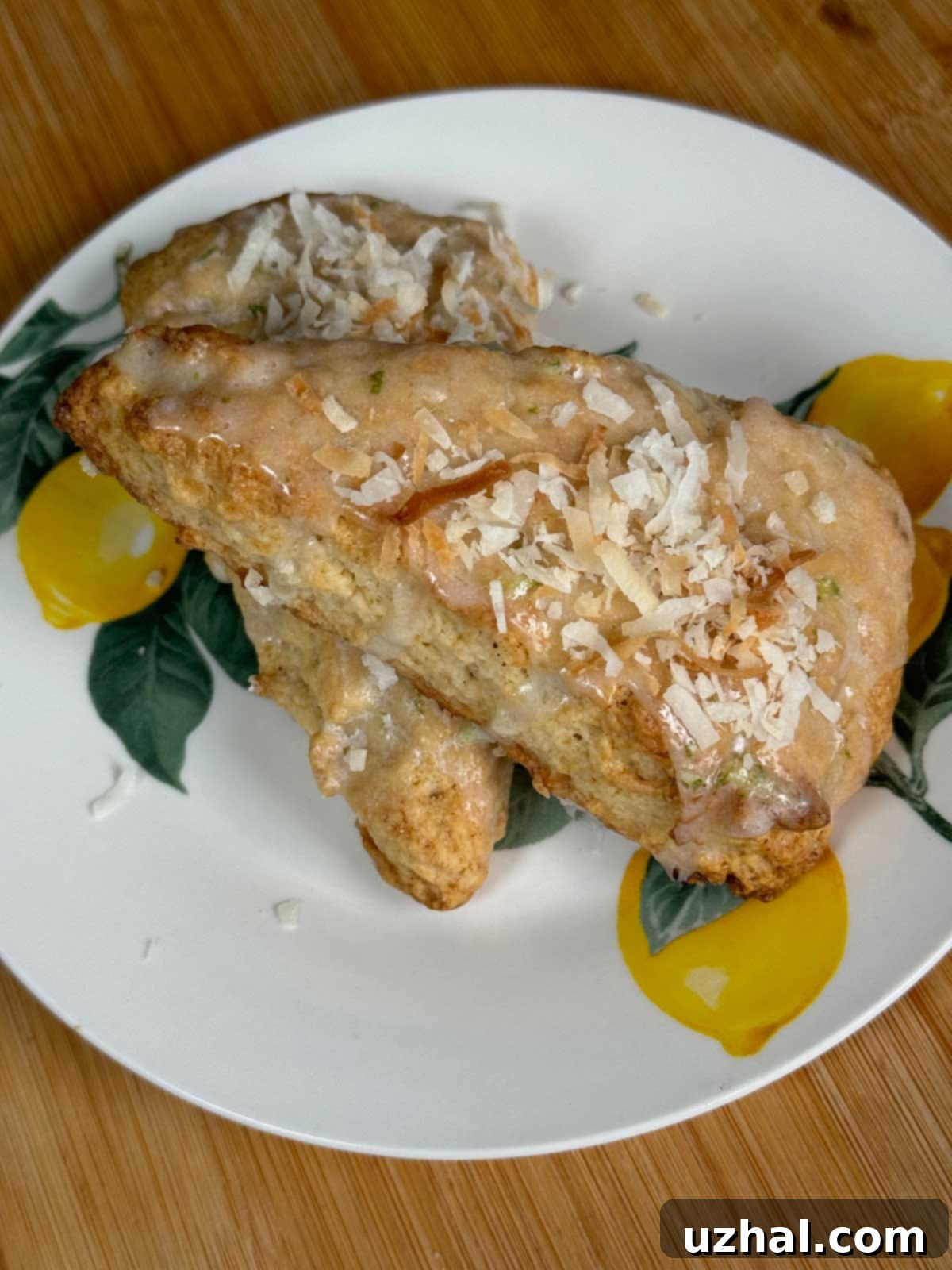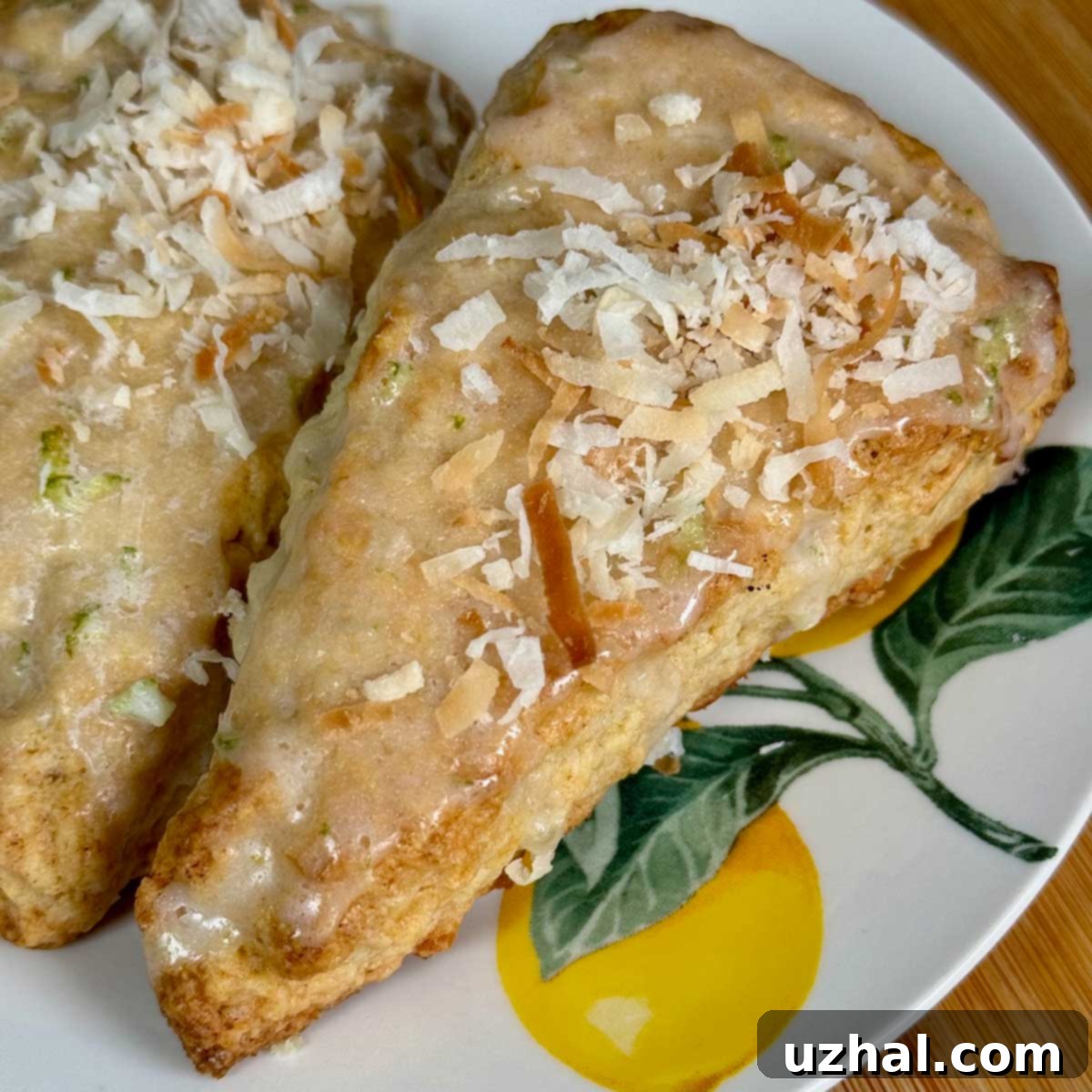Indulge in Tropical Bliss: The Ultimate Coconut Lime Scones Recipe
Imagine a bite that transports you to a sunny beach, where the subtle sweetness of coconut mingles with the vibrant tang of fresh lime. That’s exactly the delightful experience you’ll get with these truly irresistible Coconut Lime Scones. Our inspiration for this recipe sparked a few years ago after savoring a memorable coconut and lime flavored coffee cake at Zingerman’s. Craving those beloved tropical flavors but with less time for an elaborate bake, we distilled the essence into a quicker, equally satisfying scone recipe.
These homemade scones are a perfect choice whether you’re seeking a delightful breakfast pastry, a charming addition to your afternoon tea, or a simple yet elegant dessert. What makes them even more appealing is their incredible versatility – they are easily adaptable to be completely vegan, making them a fantastic option for everyone with different dietary preferences. The base recipe leans towards a rich coconut flavor, beautifully accented by a bright hint of lime and finished with a wonderfully tart lime glaze that truly makes the entire flavor profile sing. However, for those who adore the zing of citrus, you can easily adjust the recipe to bring the lime to the forefront, allowing coconut to play a more subtle supporting role. This adaptability ensures that your homemade coconut lime scones can be tailored precisely to your taste.
Jump to Recipe

Crafting the Perfect Flavor and Texture Profile
The allure of these coconut lime scones lies not just in their tropical taste, but also in their delightful texture. We strive for a scone that boasts a wonderfully soft and tender crumb, providing a comforting melt-in-your-mouth experience, yet surprises with delightfully crispy, golden-brown edges. This textural contrast creates an exciting sensation with every bite, making them truly irresistible. To achieve this ideal balance, a combination of specific ingredients and careful techniques is essential.
Customizing Your Scone’s Flavor Balance
When it comes to the flavor, you are the artist. If your palate craves a more pronounced lime experience, you can easily adjust the recipe. Simply choose to omit the coconut extract and, instead, incorporate a little extra lime zest or a few drops of high-quality food-grade lime oil. This subtle tweak will elevate the vibrant citrus notes, resulting in a truly zesty lime scone with just a whisper of coconut in the background, primarily from the coconut milk and coconut oil in the dough. Conversely, to amplify the rich, tropical coconut essence, ensure you include the coconut extract as specified. Even without added extract, the natural coconut oil and full-fat coconut milk used in the recipe provide a beautiful foundational coconut flavor that is both creamy and aromatic.
The tart lime glaze isn’t merely an optional topping; it’s an integral part of the overall flavor profile. Its bright acidity expertly cuts through the richness of the scone, creating a refreshing contrast that makes these pastries incredibly moreish and perfectly balanced. Each component works in harmony to deliver a truly memorable tropical treat that brightens any moment.

Vegan vs. Traditional: Butter and Cream or Coconut Oil and Milk?
One of the most remarkable aspects of this coconut lime scone recipe is its incredible adaptability, catering to diverse preferences. While my personal preference often leans towards the vegan version, utilizing coconut oil and coconut milk for a lovely richness and a delicate coconut aroma, these scones are equally fantastic when prepared with traditional dairy ingredients like butter and heavy cream. The choice truly depends on your dietary needs, personal taste, and the specific texture you wish to achieve.
If you opt for the classic dairy route, the substitution is delightfully straightforward. Simply use ½ cup (114 grams) of very cold unsalted butter, cut into small, even chunks, in place of the coconut oil. For the liquid component, substitute chilled heavy cream for the coconut milk, adding it gradually until a cohesive dough forms. This traditional butter and cream method typically yields scones that are noticeably flakier, characterized by distinct, luscious layers that separate beautifully when broken open. This flakiness is a result of the butter creating pockets of steam as it melts and bakes, gently pushing the dough layers apart. In contrast, the coconut oil and coconut milk version offers a slightly softer, more tender crumb, yet still manages to develop those desirable crispy edges, all while infusing the scones with a pronounced tropical aroma that perfectly complements the lime.
Both variations are exceptionally delicious, offering unique qualities that make them special. Feel empowered to experiment with both to discover which texture and flavor profile you prefer for your ultimate coconut lime scones. Whichever path you choose, a delicious outcome is guaranteed!
Essential Tips for Perfect Scone Baking Every Time
Achieving light, fluffy scones with those coveted crispy edges is often considered an art, but it’s an art that is surprisingly easy to master with just a few simple, yet crucial, techniques. Whether you’re a seasoned baker looking for consistent results or completely new to the world of scone making, these tips will guide you in creating a batch of Coconut Lime Scones that are nothing short of perfection.
- Maintain Cold Ingredients: This is arguably the most critical rule for achieving excellent scones. Cold fat (whether it’s butter or coconut oil) is paramount for creating those delightful pockets of steam during baking, which in turn leads to a light, airy, and flaky texture. Always ensure your butter or coconut oil, along with your coconut milk (or heavy cream), are thoroughly chilled before you begin mixing.
- Avoid Overmixing the Dough: This cannot be stressed enough. Overworking the dough is the quickest way to develop the gluten in the flour, which inevitably results in tough, dense, and unappetizing scones. Mix the ingredients just until they are barely combined and a cohesive dough begins to form. A few dry spots in the dough are far preferable to an overmixed, sticky consistency.
- Handle Gently: Once the dough has come together, handle it as little as humanly possible. Rather than kneading vigorously, gently pat the dough into its desired shape. This minimal handling preserves the tenderness and prevents gluten development.
- The Right Tool for Incorporating Fat: When cutting the cold fat into the flour, a pastry cutter or even your fingertips work exceptionally well. The objective is to break the fat into small, pea-sized pieces, distributing it evenly throughout the flour mixture. Avoid using your warm hands for too long if mixing by hand, as this will melt the fat.
- Use a Sharp Knife for Cutting: When it’s time to cut your shaped dough into triangles or circles, use a very sharp chef’s knife and employ a straight downward motion. Resist the urge to saw or twist the knife, as this can seal the edges of the scones, preventing them from rising properly and forming those beautiful layers.
- Brush for a Golden Top: A light brush with a little extra coconut milk (or heavy cream if using dairy) before baking works wonders. This simple step helps the tops brown beautifully, giving them an inviting golden hue and adding a subtle, rich sheen.
- Bake at High Heat: Scones truly benefit from a hot oven, typically around 400°F (200°C). The initial blast of high heat causes the liquid in the dough to rapidly turn into steam, helping the scones to rise quickly and achieve those highly desirable crispy edges and a fluffy interior.
Freezing Scones for Future Enjoyment and Convenience
One of the greatest advantages of baking scones is their exceptional ability to freeze beautifully, allowing you to enjoy fresh, warm treats anytime a craving strikes or unexpected guests arrive. This makes them perfect for efficient meal prepping or simply having a delicious backup on hand. You have a couple of excellent options when it to comes to freezing, depending on your preference for prep time later:
Freezing Unbaked Scones: The Freshest Option
If your goal is to experience the freshest possible scone, freezing the unbaked dough is highly recommended. After you’ve shaped and cut your scones into triangles (or whatever shape you prefer), arrange them in a single layer on a parchment-lined baking sheet. Place the entire baking sheet into the freezer for approximately 1 to 2 hours, or until the individual scones are completely solid. Once they are frozen solid, you can transfer them to a freezer-safe bag or an airtight container, which prevents them from sticking together. When you’re ready to bake, simply place the frozen scones directly onto a prepared baking sheet and bake as directed in the recipe. You’ll typically need to add an extra 5 to 10 minutes to the baking time, or until they are beautifully golden brown around the edges and cooked through. There’s absolutely no need to thaw them first, which saves precious time!
Freezing Baked Scones: Quick Reheating
Alternatively, you can choose to bake the scones first and then freeze them. This method is incredibly convenient for quick thawing and reheating. Once your scones are baked to perfection and the lime glaze (if you’re using it) has been applied and fully set, allow them to cool completely at room temperature. For scones with glaze, it’s a good idea to freeze them on a baking sheet first, just until the icing is solid. This prevents the glaze from sticking to the wrapping. Once solid, individually wrap each scone tightly in plastic wrap, then place them into a larger freezer-safe bag or an airtight container. They will maintain their quality and flavor well for up to 2 to 3 months.
Reheating Frozen Scones: Methods for Perfection
To enjoy a frozen baked scone, you have a few excellent options for reheating that help restore their fresh-from-the-oven deliciousness. For a super quick thaw, you can microwave a scone for 30 to 60 seconds (depending on your microwave’s power), then warm it slightly in a toaster oven for a few minutes to crisp up those wonderful edges. Alternatively, for a more even reheat that mirrors freshly baked, you can place them in a preheated oven (around 300°F or 150°C) for about 10 to 15 minutes, or until they are warmed through to the center. This gentle reheating method helps to preserve their tender interior and crisp exterior. Just be mindful not to overheat them, as this can unfortunately dry them out.
Serving Your Tropical Scones
These Coconut Lime Scones are so incredibly flavorful and delightful on their own that they truly don’t require much accompaniment. However, they pair wonderfully with a few simple additions that can enhance their tropical charm. Enjoy them warm with a steaming cup of coffee, or for a refreshing twist, alongside a glass of chilled iced tea for a perfect morning or afternoon treat. A generous dollop of freshly whipped cream can add a luxurious texture, or a side of mixed fresh berries will complement their bright flavors beautifully. For an extra touch of indulgence, consider a small dish of tangy lime curd or a delicate drizzle of honey.
- Cinnamon Oat Scones
- Whipping Cream Scones
- Blueberry Lime Pound Cake
- White Chocolate Cranberry Ginger Cream Scones
- Maple Oat Scones
Recipe: Coconut Lime Scones

Coconut Lime Scones
Anna
Pin Recipe
Ingredients
- ⅓ cup granulated sugar (70 grams)
- 1 tablespoon lime zest
- ¼ cup shredded sweetened coconut (optional, for extra coconut flavor)
- 2 cups all-purpose flour (270 grams)
- 1 tablespoon baking powder
- ½ teaspoon salt
- ½ cup cold vegan butter, cut into chunks or 114 grams cool room temperature coconut oil or just regular butter
- ¾ cup chilled coconut milk plus more as needed (full fat type, or use heavy cream for non-vegan)
- ¼ teaspoon coconut extract OR use ½ teaspoon lime oil (optional, for intensified flavor)
Lime Glaze
- ½ tablespoon melted butter or coconut oil (for vegan, use coconut oil)
- ½ cup confectioners’ sugar
- 1 ½ tablespoon fresh lime juice or as needed
- ¼ cup toasted coconut (optional, for garnish)
Instructions
-
Preheat your oven to 400ºF (200ºC). Prepare a baking sheet by lining it with parchment paper to prevent sticking.
-
In a large mixing bowl, thoroughly combine the granulated sugar, fresh lime zest, and the optional shredded sweetened coconut. Stir them together until well blended and fragrant.
-
Add the all-purpose flour, baking powder, and salt to the sugar mixture. Stir everything gently until these dry ingredients are evenly blended. Next, add the cold vegan butter (cut into small chunks) or the cool room temperature coconut oil (or regular butter if not making vegan). Use your fingers or a pastry cutter to incorporate the fat into the flour mixture until it resembles coarse crumbs, with some pea-sized pieces of fat remaining.
-
In a separate small bowl, whisk together the ¾ cup of chilled full-fat coconut milk (or heavy cream) with either the coconut extract or the lime oil (depending on your flavor preference). Gradually add this liquid mixture to the flour and fat mixture, stirring with a sturdy spatula or heavy-duty scraper. Mix just until the dough begins to come together. Be careful not to overmix. If the dough appears too dry, add a very small amount of additional coconut milk, one teaspoon at a time, until a soft, cohesive dough forms.
-
Lightly flour a clean work surface or a baking mat. Scrape the dough out onto the floured surface. Gently pat and shape the dough into a uniform 7-inch (18 cm) circle, about ¾ to 1 inch thick. Avoid kneading the dough.
-
Take a large, sharp chef’s knife and lightly grease its blade. Using a straight downward motion (do not saw or twist), cut the dough circle into 8 equal triangles. Carefully transfer these triangles to your parchment-lined baking sheet, spacing them about 2 inches apart to allow for even baking. For a beautiful golden finish, lightly brush the tops of the unbaked scones with a little more coconut milk or cream.
-
Bake the scones in your preheated 400°F (200ºC) oven for approximately 18 to 20 minutes. They are ready when their edges are beautifully browned and they are fully baked through, feeling firm to the touch.
-
While the scones are baking or cooling slightly, prepare the vibrant lime glaze. In a small bowl, whisk together the melted butter (or coconut oil/vegan margarine) and confectioners’ sugar. Gradually add the fresh lime juice, starting with 1 ½ tablespoons, and continue stirring until the mixture is smooth, thick enough to spread, but still pourable. Once the scones have cooled for a few minutes (they should still be warm, not hot), spread the luscious lime glaze generously over their tops. Let the glaze melt and set slightly. If desired, sprinkle the tops with extra toasted coconut for an added crunch and visual appeal. Serve warm and enjoy your homemade tropical treat!
Notes
